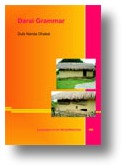Darai Grammar
Dhakal, Dubi Nanda:
Darai Grammar / Dubi Nanda Dhakal. - München : LINCOM Europa, 2012. - XI, 198 S. - (Languages of the world : Materials ; 489)
ISBN 978-3-86288-310-3
EUR 64,80
DDC: 491.4547
Beschreibung
This grammar is a description of Darai, an Indo-Aryan language, which was not adequately described before. The genetic classification of this language has not been determined yet but proposed as an eastern Indo-Aryan language. It is a language spoken by 10210 people in the Chitwan, Nawalparasi and Tanahun districts of central and western Nepal. The Darai people residing in Nayabeltari and Gaindakot Village Development Committees (VDCs) in Nawalparasi and Gajarkot in Tanahu no longer speak their ancestral language. The data for this grammar came largely from the natural texts. The text corpus was mainly obtained from the language consultants who were the inhabitants of Kathar, Chainpur, Mangalpur VDCs and Bharatpur municipality of the Chitwan district.
Synchronic description of phonology is given in chapter two. Darai has 29 consonants and 6 vowels. This chapter examines the vowels and consonants, their distribution, consonant clusters, syllable structure and morphophonology. Chapter three discusses the morphology. Nouns inflect for number, pronominal possessive marking, indefinite marking and cases. The pronominal possessive suffixes are used to mark the kinship relations as well as ownership. The indefinite marker attached to noun is also an interesting feature. Darai is characterized as a split ergative language which is based on nominal hierarchy. The semantic categories and functions of adjectives are also analyzed in this chapter. In addition to tense, aspect and mood, Darai verbs are characterized by modality marking such as obligation, possibility, inference, mirativity, hearsay, frustative and dubitative. A Darai bitransitive verb may cross-reference both the actor and patient. Verb agreement is also triggered by number, gender, case, honorificity as well as pragmatic features. Verb agreement due to focus hierarchy is a striking feature characterized Darai. Different kinds of adverbs are also dealt with in this chapter. This chapter also analyzes the word classes such as clitic, particles, onomatopoeia and echo words. Some native Darai particles are widely used in natural discourse despite the influences from neighboring languages in lexicon. Chapter 4 deals with syntax. This chapter first of all presents the word order. This chapter also discusses the simple sentence in Darai in addition to the modifications of simple sentences. This chapter discusses the clause combining, such as complement clauses, relative clauses and adverbial clauses. Clause combining is productive because of morphosyntactic evidences seen in Darai grammar. The grammatical features exhibit that Darai may be classified as an 'eastern' Indo-Aryan language closely related to Maithili, Bhojpuri and Majhi. [Verlagsinformation]
Inhalt
Acknowledgements. i
List of tables, figures and plate. viii
Abbreviations. ix
I. INTRODUCTORY REMARK
1.1 Origin and name. 1
1.2 Darai villages: Demography and geography. 2
1.3 Previous studies. 3
1.4 Typological profile. 4
II. PHONOLOGY
2.0 Outline. 5
2.1 Vowel phonemes. 5
2.2 Consonant phonemes. 9
2.3 Syllable structure. 17
2.4 Intonation. 21
2.5 Morphophonology. 21
III. MORPHOLOGY
3.0 Outline. 24
3.1 Nouns. 24
3.2 Pronouns. 44
3.3 Adjectives. 52
3.4 Verbs and verb morphology. 64
3.5 Adverbs. 100
3.6 Clitic. 109
3.7 Particles. 110
3.8 Interjections. 113
3.9 Onomatopoeia. 113
3.10 Echo formations. 115
IV. SYNTAX
4.0 Outline. 116
4.1 Constituent order. 116
4.2 Noun phrases. 117
4.3 Clause types. 126
4.4 Sentence modifications. 130
4.5 Displacement. 138
4.6 Valence adjusting operations. 139
4.7 Clause combining. 144
4.8 Direct and indirect speech. 164
4.9 Summary. 165
4.10 Proposed classification of the Darai language. 166
APPENDICES
Appendix 1: Verb paradigms
Appendix 2: Index of grammatical morphemes
Appendix 3: Sample text
REFERENCES
Autor
DUBI NANDA DHAKAL, Tribhuvan University, Nepal
Quellen: Lincom; Deutsche Nationalbibliothek; Buchhandel.de; Amazon (Deutschland); Lehmanns Media; Linguist List
Dhakal: Darai Grammar, 2012
Ähnlich
- Mylius: Lehrbuch der Ardhamāgadhī
- Vedic and Sanskrit Historical Linguistics
- Mylius: Zur Didaktik mittelindischer Sprachen
- Modi: Some Issues in Gujarati Phonology
- Indic across the Millennia
- Poudel: Eastern Nepali Grammar
- Verbeke: Alignment and Ergativity
- Linguistic Developments along the Silkroad
- A Grammar of Domari
- Grammar of Hadoti

